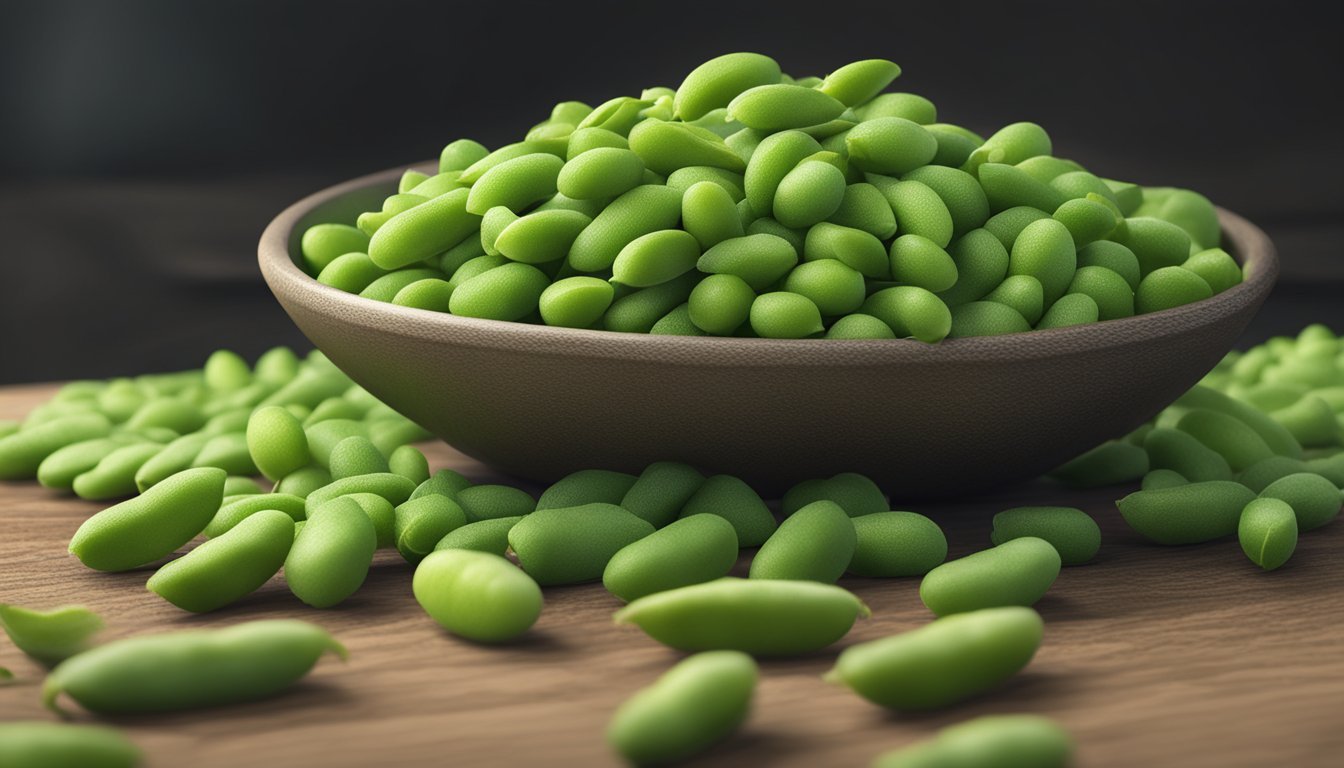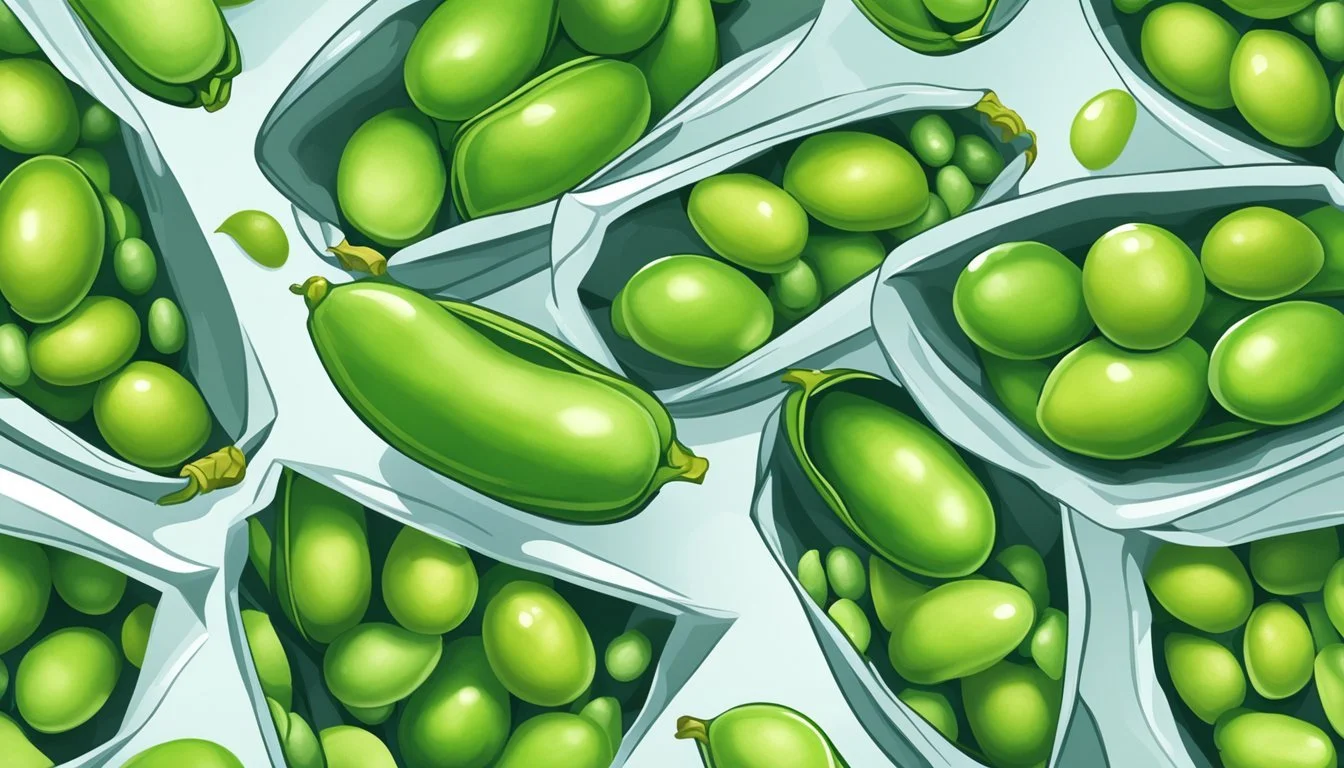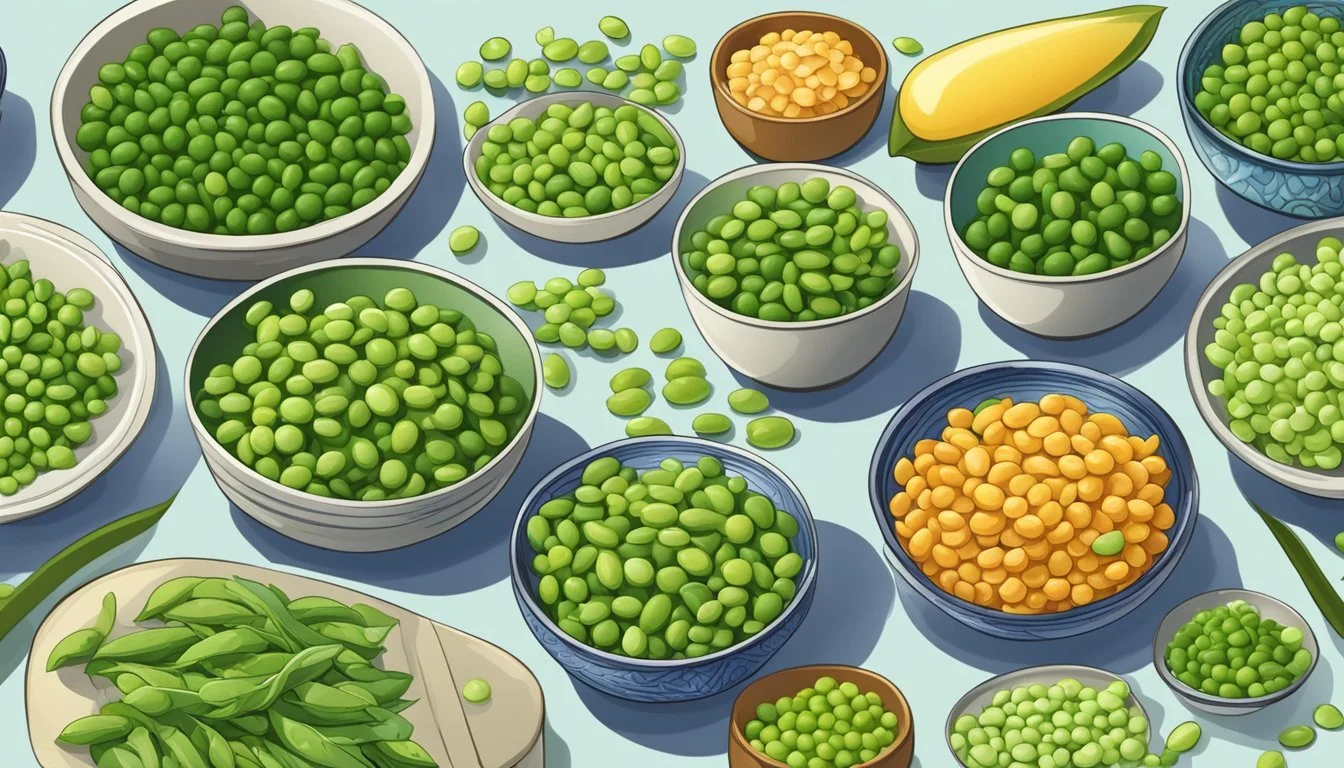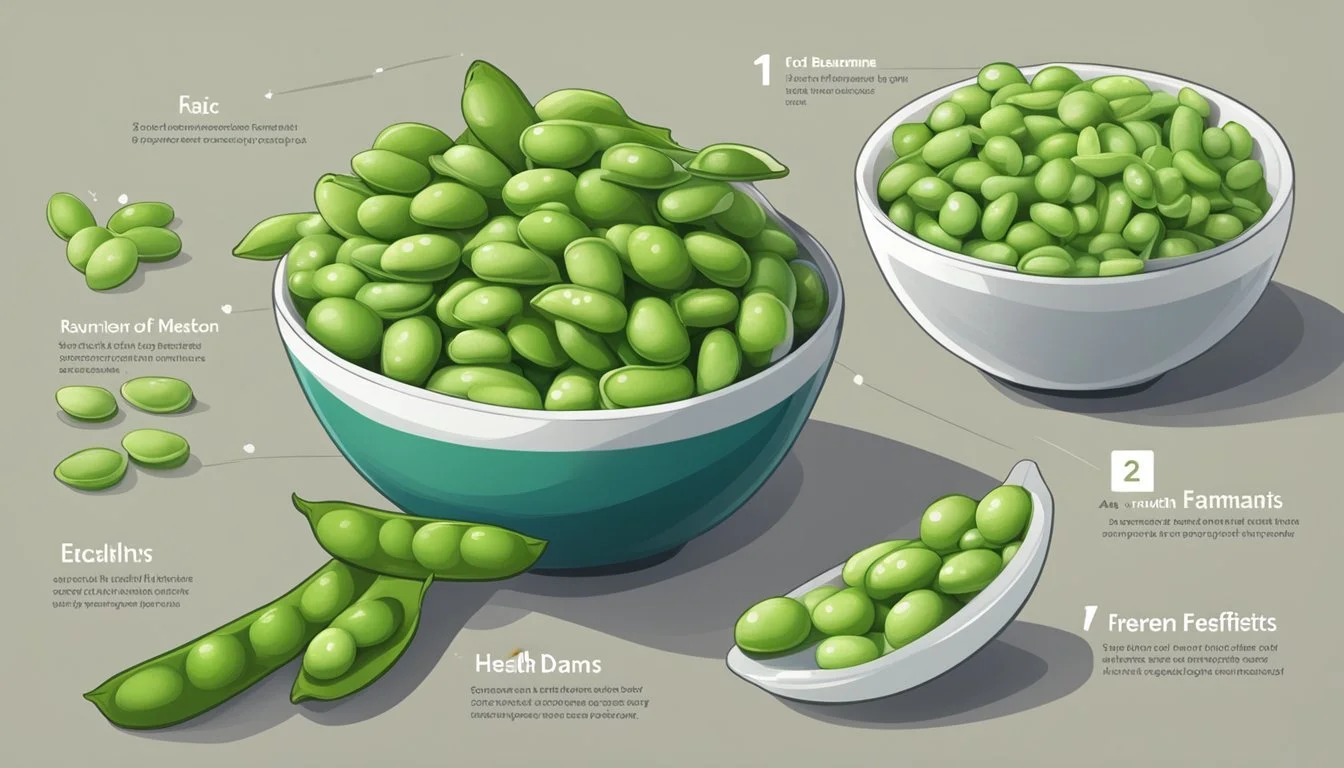Frozen vs Fresh Edamame: Which Bean Reigns Supreme?
Edamame, the vibrant green soybeans popular in Japanese cuisine, offer a delicious and nutritious snack or ingredient. Whether fresh or frozen, these protein-packed pods provide a versatile addition to many dishes.
Both fresh and frozen edamame can be equally nutritious, but frozen edamame is often more readily available and convenient. Fresh edamame has a slightly sweeter taste and firmer texture, while frozen edamame maintains its nutrients and flavor well when properly stored.
Cooking edamame is simple, regardless of its form. Fresh edamame pods can be boiled or steamed for 3-5 minutes, while frozen edamame typically requires 4-5 minutes of cooking time. Once cooked, both varieties can be enjoyed warm or chilled, seasoned with salt or other flavorings to taste.
Understanding Edamame
Edamame are immature soybeans, typically harvested while still green and tender. These legumes are packed with nutrients, making them a popular choice for health-conscious consumers.
Edamame is an excellent source of plant-based protein. A single cup of cooked edamame provides about 18 grams of protein, making it a valuable addition to vegetarian and vegan diets.
These green soybeans are rich in fiber, which aids digestion and promotes feelings of fullness. They also contain essential minerals such as iron, potassium, calcium, and magnesium.
Edamame is a good source of vitamins, particularly folate and vitamin K. Folate is crucial for cell growth and DNA formation, while vitamin K plays a role in blood clotting and bone health.
The nutritional profile of edamame includes:
Low calories
High protein content
Rich in fiber
Contains healthy fats
Abundant in vitamins and minerals
Edamame also contains phytosterols, plant compounds that may help lower cholesterol levels. These compounds contribute to the overall health benefits of consuming edamame regularly.
Fresh edamame pods are typically bright green and slightly fuzzy. When buying fresh, look for firm, unblemished pods. Frozen edamame is widely available and retains much of its nutritional value.
Comparing Frozen and Fresh Edamame
Edamame comes in both frozen and fresh forms, each with distinct characteristics. These differences impact their taste, nutrition, and convenience.
Nutritional Differences
Frozen edamame retains most of its nutrients due to quick freezing after harvest. This process preserves vitamins and minerals effectively. Fresh edamame may have slightly higher vitamin C content, as some is lost during freezing.
Both forms provide comparable protein, fiber, and essential amino acids. Frozen edamame maintains its nutritional value for months when stored properly. Fresh edamame's nutrient content can decline more rapidly over time.
Flavor and Texture
Fresh edamame often has a sweeter, more vibrant flavor compared to frozen. The beans are typically more tender and have a brighter green color. Frozen edamame can sometimes be slightly less flavorful but still maintains a good taste.
Texture-wise, fresh edamame tends to be crisper. Frozen edamame may be slightly softer after thawing and cooking. Both can achieve a similar tender texture when cooked properly.
Convenience and Shelf Life
Frozen edamame is widely available year-round in the freezer aisle. It has a long shelf life of several months when stored properly. Frozen edamame comes both shelled and in pods, offering versatility for different recipes.
Fresh edamame has limited seasonal availability and a shorter shelf life of about a week when refrigerated. It requires more preparation, as it's often sold still on the stalk.
Frozen edamame is more convenient for quick meals. It can be microwaved or added directly to recipes. Fresh edamame needs to be cooked soon after purchase to maintain quality.
How to Cook Edamame
Edamame can be prepared through several simple cooking methods. The key is to achieve tender beans with a slightly crisp texture and bright green color.
Boiling Edamame
Fill a pot with enough water to fully submerge the edamame. Add a pinch of salt to enhance flavor. Bring the water to a rolling boil over high heat.
Add the edamame pods to the boiling water. Cook for 4-5 minutes until the beans are tender but still have a slight crunch.
Drain the edamame in a colander. Rinse briefly with cold water to stop the cooking process if serving chilled. For warm edamame, skip the rinse.
Sprinkle with additional salt if desired. Serve immediately for the best taste and texture.
Steaming Edamame
Place a steamer basket in a pot with about 1 inch of water. Ensure the water doesn't touch the basket. Bring the water to a boil over high heat.
Add the edamame pods to the steamer basket. Cover the pot and steam for 5-7 minutes until the beans are tender-crisp.
Remove the steamer basket from the pot. Season the edamame with salt to taste. Serve warm or allow to cool slightly before eating.
Microwaving Edamame
Place edamame pods in a microwave-safe bowl. Add 2 tablespoons of water for every cup of edamame.
Cover the bowl with a microwave-safe lid or plastic wrap, leaving a small vent for steam to escape.
Microwave on high for 1-2 minutes per cup of edamame. Check for doneness and stir halfway through cooking.
Let the edamame stand for 1 minute before carefully removing the cover. Drain any excess water and season with salt.
Preparation Methods for Frozen Edamame
Frozen edamame can be cooked directly from frozen without thawing. Add 1-2 minutes to the cooking time for any method.
For boiling, add frozen edamame to boiling salted water. Cook for 5-6 minutes until heated through.
To steam, place frozen pods in a steamer basket over boiling water. Steam for 6-8 minutes until tender.
Microwave frozen edamame in a covered dish with a small amount of water for 2-3 minutes per cup, stirring halfway through.
For a quick snack, sauté frozen edamame in a pan with oil over medium-high heat for 3-4 minutes, stirring frequently.
Creative Ways to Serve Edamame
Edamame offers versatility in both appetizers and main dishes. Its vibrant color and nutritional benefits make it an excellent addition to various cuisines.
Edamame as an Appetizer or Snack
Edamame shines as a simple yet satisfying appetizer or snack. Serve steamed edamame pods sprinkled with sea salt for a traditional Japanese starter. For a twist, toss cooked edamame with garlic powder, chili flakes, and a squeeze of lemon juice.
Create edamame hummus by blending shelled edamame with tahini, olive oil, and spices. This makes a unique dip for vegetables or pita chips. Another option is edamame guacamole, combining mashed edamame with avocado, lime juice, and cilantro.
For a crunchy snack, roast shelled edamame in the oven with olive oil and seasonings until crispy. These make an excellent alternative to nuts for those with allergies.
Incorporating Edamame into Salads
Edamame adds protein and texture to salads. Create a simple edamame and corn salad with cherry tomatoes, red onion, and a light vinaigrette. For a heartier option, combine edamame with quinoa, feta cheese, and diced cucumber.
In Asian-inspired salads, mix edamame with shredded cabbage, carrots, and a sesame ginger dressing. For a Greek twist, toss edamame with orzo pasta, olives, and crumbled feta cheese.
Edamame also works well in grain bowls. Combine it with brown rice, roasted vegetables, and a tahini dressing for a nutritious meal. In poke bowls, edamame complements raw fish, avocado, and pickled vegetables.
Main Dishes Featuring Edamame
Edamame can elevate main courses with its protein content and bright color. Add it to stir-fries with other vegetables and tofu or chicken for a balanced meal. In pasta dishes, mix edamame with whole wheat spaghetti, olive oil, garlic, and Parmesan cheese.
For a hearty vegetarian option, create an edamame and mushroom risotto. The edamame adds texture and nutritional value to the creamy rice dish. In soups, add edamame to miso or vegetable broths for extra substance.
Edamame also works well in sushi rolls. Combine it with avocado and cucumber for a vegetarian roll, or add it to rolls with cooked fish for extra nutrition.
Edamame in Vegan and Vegetarian Diets
Edamame serves as an excellent protein source for plant-based diets. Use it to make vegan "meatballs" by blending edamame with breadcrumbs, herbs, and spices. These can be served with pasta or in sandwiches.
Create a protein-packed edamame pesto by blending edamame with basil, garlic, and nutritional yeast. This makes a great sauce for pasta or a spread for sandwiches. For breakfast, add edamame to tofu scrambles for extra protein and texture.
In Buddha bowls, combine edamame with roasted sweet potatoes, kale, and a tahini dressing. This creates a balanced, nutrient-dense meal. Edamame can also be added to veggie burgers for extra protein and a vibrant green color.
Seasoning and Enhancing Edamame
Edamame can be elevated from a simple snack to a flavorful dish with the right seasonings and pairings. Creative combinations can transform this versatile legume into a memorable culinary experience.
Simple Seasonings
Salt is the classic seasoning for edamame. A sprinkle of sea salt or kosher salt brings out the natural flavors of the beans. For added depth, try garlic salt or a blend of salt and pepper.
Soy sauce provides a savory umami taste. Drizzle it lightly over cooked edamame pods for an instant flavor boost. For a nuttier profile, toasted sesame oil works well. Just a few drops go a long way.
Sesame seeds, either plain or toasted, add texture and a subtle nutty flavor. Sprinkle them over the pods after cooking. They pair especially well with salt or soy sauce.
Creative Flavor Pairings
Miso paste creates a rich, complex flavor. Mix it with a little water to form a glaze, then brush onto cooked edamame. This works particularly well when the pods are grilled or roasted.
Garlic and chili flakes offer a spicy kick. Sauté minced garlic in oil, add red pepper flakes, then toss with cooked edamame. This combination delivers heat and aromatic notes.
For an Asian-inspired twist, try a mixture of soy sauce, sesame oil, and rice vinegar. This tangy-sweet blend complements the natural flavor of the beans perfectly.
Experiment with herbs like cilantro or mint. Finely chop and sprinkle over the pods just before serving. These fresh flavors add brightness to the dish.
Health Benefits of Edamame
Edamame offers impressive nutritional benefits as a plant-based protein source. It contains all nine essential amino acids, making it a complete protein ideal for vegans and vegetarians.
Rich in fiber, edamame supports digestive health and helps maintain stable blood sugar levels. It provides important minerals like iron, potassium, and calcium.
Edamame is packed with vitamins, including folate and vitamin K. One cup of edamame can provide up to 50% of the daily folate requirement for women.
The soy isoflavones in edamame may have protective effects against certain cancers. Some studies suggest regular consumption could lower cancer risk, particularly for breast and prostate cancers.
Edamame is heart-healthy, containing no cholesterol and minimal saturated fat. Its fiber and protein content can help promote feelings of fullness and support weight management.
As a versatile legume, edamame can be easily incorporated into various dishes. Whether fresh or frozen, it retains its nutritional value, making it a convenient and healthy addition to meals.
Purchasing and Storing Tips
Proper selection and storage of edamame ensure optimal freshness and flavor. Whether buying fresh or frozen, knowing where to find quality edamame and how to store it properly is key.
Where to Buy Edamame
Fresh edamame can be found in the produce section of many grocery stores and Asian markets. Look for bright green pods that are firm and free from blemishes.
Frozen edamame is widely available in the freezer aisle of most supermarkets. It's often sold both in and out of the pod.
Some farmers' markets may offer locally grown fresh edamame when in season.
For convenience, many stores also stock pre-cooked, ready-to-eat edamame in the refrigerated section.
How to Store Edamame
Fresh edamame should be refrigerated promptly. Store it in a perforated plastic bag in the crisper drawer.
Use fresh edamame within 2-3 days for best quality.
Frozen edamame can be stored in the freezer for up to 12 months. Keep it in its original packaging or transfer to an airtight container.
Once cooked, refrigerate leftover edamame in an airtight container and consume within 3-5 days.
Avoid storing uncooked edamame at room temperature, as it can spoil quickly.
For long-term storage, blanch fresh edamame before freezing to preserve its color and nutrients.







